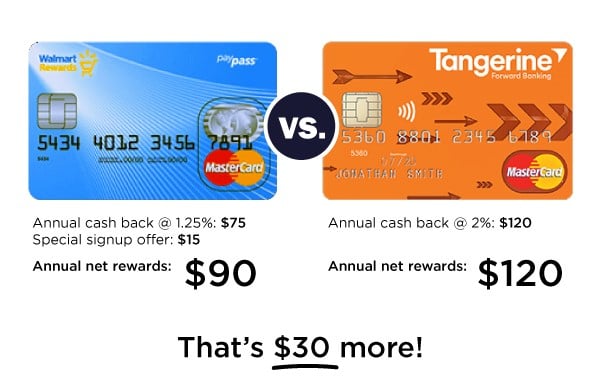Grocery Battle: Walmart Rewards MasterCard vs. Tangerine Money-Back Credit Card
I want you to take a moment and visualize your budget.
Now think of the budget categories that you’d consider big-ticket items. Which line items jump out at you?
Your rent or mortgage payment? What about spending on gas and insurance?
These items are typically large expenses for most families, but there’s another budget category that adds up to thousands of dollars per year, and many Canadians take it for granted as a necessary expense: Groceries. The average Canadian household spends $200 per month, per person, on groceries. For a family of four, that adds up to almost $10,000 in spending per year — just on food!
That’s where cash-back credit cards come in. While there are many strategies to reduce your spending, there are fewer ways to ensure this mandatory spending is earning you the highest amount of rewards possible. Let’s compare two of the best credit cards for grocery spending today: the Walmart Rewards MasterCard and the Tangerine Money-Back Credit Card.
If you’re considering either of these credit cards to maximize your rewards for spending on groceries, a clear winner quickly emerges: the Tangerine Money-Back Credit Card, which gives you 2% cash back on spending at any recognized grocery store, including Walmart — note that only purchases at locations designated as Walmart Supercentres qualify. Cash back is refunded monthly, and can be applied as a credit to your statement or deposited into a Tangerine savings account. This flexibility gives you greater freedom to price compare and shop sales at different grocery stores, and to use the cash any way you want.
Let’s compare the two cards to see exactly how much cash back you’ll earn:
The Walmart Rewards MasterCard lets you earn 1.25% of your purchase in Walmart Rewards when you shop at Walmart stores in Canada, and 1% back in rewards everywhere else. Walmart Rewards are earned in dollar equivalents, not points, so it’s easy to know how much you have to redeem. Points can be redeemed in $5 increments, and you can start claiming them when you’ve earned a minimum of $5. The card offers two sign-up bonuses: $15 in Walmart Rewards when you use the credit card one at Walmart and once at another retailer, and $10 in rewards for going paperless. This card’s biggest caveat is that you can only spend your rewards at Walmart.
Assuming a monthly grocery budget of $500 (and ignoring all other spending), here’s your return:
The Tangerine Money-Back Credit Card gives you 2% cash back in your chosen categories and 0.5% cash-back on all other purchases. If you choose groceries as one of your categories, you’ll be free to buy groceries at a variety of retailers and you’ll earn $120 per year.
Here’s how much cash back you’ll earn with the same monthly grocery budget of $500:
The bottom line
Beyond the rewards considerations, the two credit cards are similar. They are both no-fee credit cards with no annual income requirement, and the interest rate on purchases is very similar at 19.89% for the Walmart Rewards MasterCard and 19.95% for the Tangerine Money-Back Credit Card.
Finally, once you earn those rewards, the difference between how you can spend them between these two credit cards is also compelling. With the Walmart Rewards Mastercard, you can only spend your rewards at Walmart. The Tangerine Money-Back Credit Card gives you two options: first, you can choose to have your rewards deposited back into your savings account (which also unlocks an additional rewards category, for a maximum of three) or you can choose to have the money deposited back onto your credit card.
While it may be tempting to sign up for the Walmart Rewards MasterCard while you’re in the store, especially if you’re a regular shopper, consider comparing the best cash-back credit cards to find one that will earn you more cash back and/or rewards and give you better flexibility.
Also read:
